The Zire Series was Palm, Inc's "consumer-grade" brand of Personal Digital Assistant.
Casio Cassiopeia was the brand name of a PDA manufactured by Casio. It used Windows CE as the Operating system. Casio was one of the first manufacturers of PDAs, developing at the beginning small pocket-sized computers with keyboards and grayscale displays and subsequently moving to smaller units in response to customer demand.
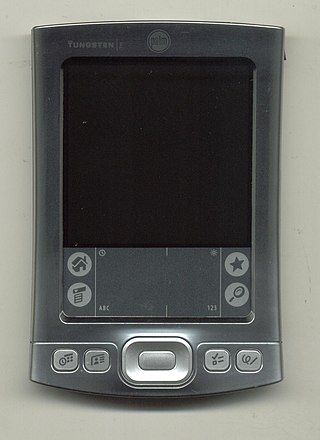
The Tungsten series was Palm, Inc.'s line of business-class Palm OS-based PDAs.
The Samsung SPH-i500 was a Palm OS-based smartphone manufactured by Samsung Electronics. It was previewed at CommunicAsia 2002 in June and launched later that year. It was later discontinued in August 2005. It was marketed in the United States for use on Sprint's mobile phone network.
The Ruputer is a wristwatch computer developed in 1998 by Seiko Instruments, a subsidiary of the Seiko Group. In the US, it was later marketed as the onHand PC by Matsucom.
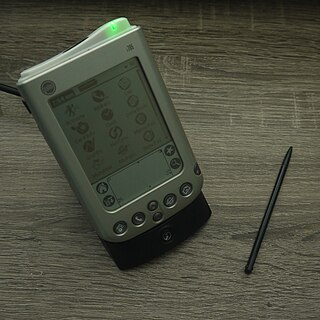
The Palm i705 was an upgrade from the last series of Palm PDAs to use the now discontinued Palm.net service via Mobitex to access the World Wide Web from Palm devices. It featured 8MB of onboard memory and an SD/MMC slot for additional storage or SDIO cards. It used the Motorola Dragonball VZ 33 MHz processor and ran Palm OS 4.1, it was noted as being the first Palm.net capable device without a flip out antenna and with an internal rechargeable battery, although it was the third and final of the three models manufactured by Palm that were capable of utilizing this network.
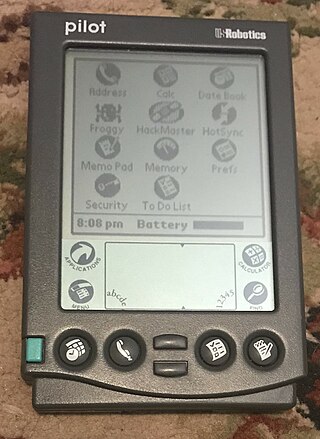
The Pilot 1000 and Pilot 5000 are the first generations of PDAs produced by Palm Computing. It was introduced in March 1996.

The Palm IIIxe is a discontinued Palm personal digital assistant that was designed and manufactured by Palm, Inc. It cost US$249 when new.
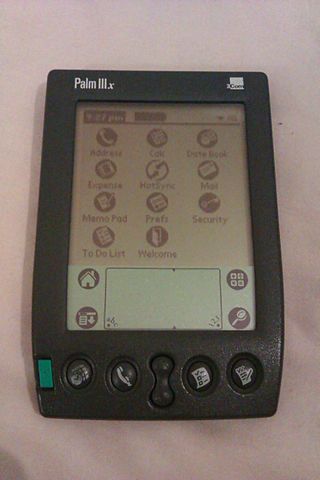
The Palm IIIx is a PDA from Palm Computing released in 1999, briefly before the scaled down Palm IIIe was introduced into the marketplace.
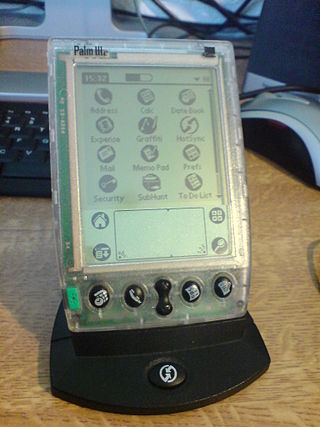
The Palm IIIe is a PDA from Palm Computing released in 1999 briefly after the more expensive and more advanced Palm IIIx.
The Palm m500 series of handheld personal digital assistants consisted of three devices: the Palm m500, Palm m505, and Palm m515. The series was a follow-up to the popular Palm V series with a similar, though slightly shorter, footprint and form factor.
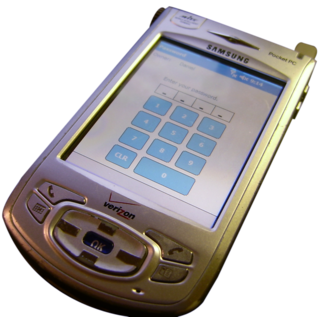
The SPH-i700 is a Windows Mobile-powered smartphone manufactured by Samsung of Korea. It is a powerful and expandable second generation Pocket PC phone compared to others in its class. It includes a transflective display, a VGA camera, 300 MHz Processor and supports SDIO, making it a competent PDA. It includes a complete bundle of accessories, including: a case, stereo headset-mic, cradle and both a regular and extended battery. The wireless radio was reported to get strong signals, and offered good voice quality and fast data speeds on Verizon's Express Network. The unit runs the Pocket PC 2002 Phone Edition OS, and in July 2004, Verizon started shipping units running Windows Mobile 2003 Phone Edition. Windows Mobile 2003 Phone Edition offers the same improvements found in regular Pocket PCs running this OS: improved Pocket Internet Explorer, always on networking, an improved networking connection manager and overall speed improvements. Samsung makes a similar model called the SGH-i700 which is identical to the SPH-i700 except for it works on the GSM/GPRS network.

HandEra was a manufacturer, software developer, and service contractor. HandEra's business previously revolved around Palm OS, and devices running Palm OS. The company's headquarters were in Des Moines, Iowa.

The Clie PEG-N760C is a Personal Digital Assistant (PDA) made by Sony. The PEG-N760C ran Palm OS, and was one of the first Palm OS devices to have a High-Res Color Screen and a built in MP3 Player.
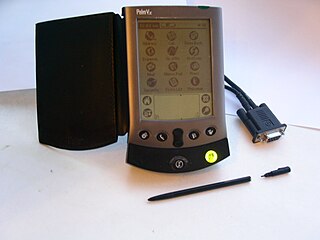
The Palm Vx was a personal digital assistant made by the Palm Computing division of 3Com. It benefited from the sleek design and low weight of its predecessor, the Palm V, while increasing the available storage to 8 MB. At 114 grams, it was one of the lightest models ever offered by Palm. Retail price at launch was US$399.
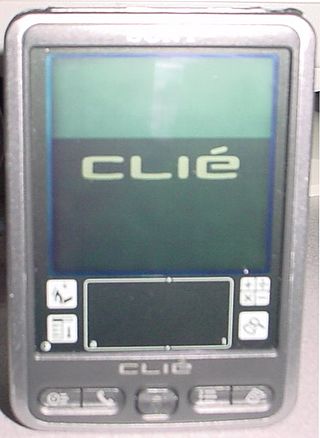
The Sony CLIÉ PEG-SL10 is a Personal digital assistant made by Sony. It was released in 2002 alongside PEG-SJ20 and PEG-SJ30, two higher end models features better screen and built-in lithium battery. All three products feature with Motorola Dragonball VZ 33Mhz Processor and Palm OS 4.1S
Handspring, Inc. was an American electronics company founded in 1998 by the founders of Palm, Inc. after becoming dissatisfied with the company's direction under new owner 3Com. The company developed Palm OS–based Visor- and Treo-branded personal digital assistants. In 2003, the company merged with Palm, Inc.'s hardware division.
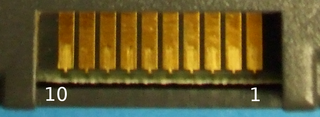
The Palm Serial were 3 successive proprietary 10-pin Serial connectors on the bottom of the first 3 series of models of PDAs from Palm, Inc. to provide serial communications: 1) pre-IrDA models; 2) the 1st IrDA models; 3) the 1st thin, metal-body models. In addition to Palm's models similar serial connectors have been used in the Ericsson MC16 Palmtop and Handera equipment. Pressing the HotSync button located at the base of the cradle closes a circuit between pins 2 and 7 which causes the activation of MUN2214 NPN transistor connected to pin 38 of the Motorola Dragonball CPU that provides a low signal on the IRQ1 UART, triggering the HotSync process. On pin 8 when a modem connects to the Palm similarly closes a circuit pin 2 to activate another MUN2214 NPN transistor connected to pin 32 of the CPU to notify the presence of the modem.
The Clié PEG-TG50 is a Personal Digital Assistant (PDA) which was manufactured by Sony, released in March 2003. Running the Palm operating system, the TG50 was notable as it featured a built-in backlit mini qwerty keyboard, in lieu of a dedicated handwriting recognition area as was the trend on most other PDAs.















